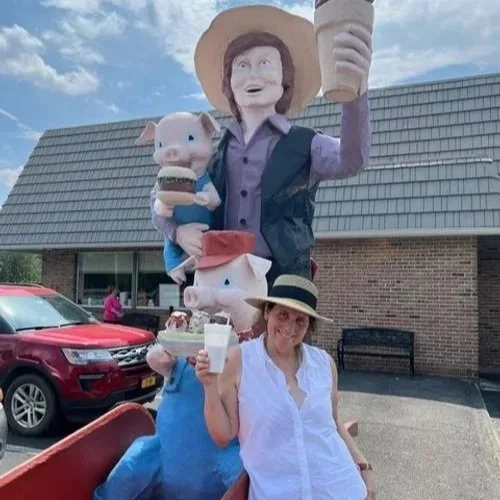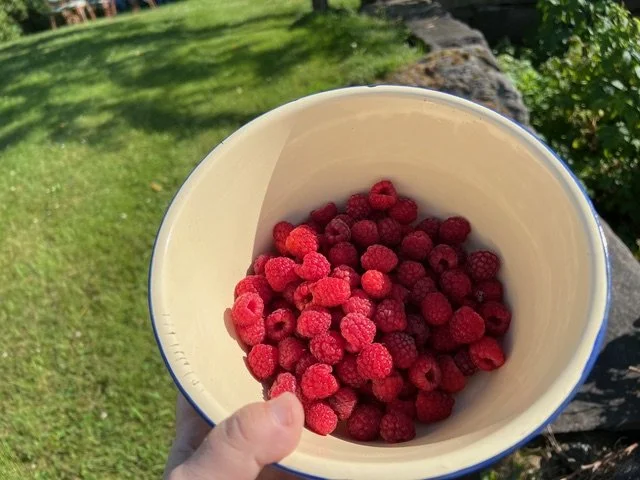The Power of a Summer Classic
"The real voyage of discovery consists not in seeking new landscapes,
but in having new eyes." — Marcel Proust
As someone who loves to travel and experience new things—and who also cherishes seeing familiar surroundings with fresh perspective—I’ve always loved the Proust quote above. You don’t need to go anywhere to have a travel experience. You can have one right in your own backyard.
Each summer, I feel a quiet yearning to experience at least one classic moment that feels quintessentially like summer. Even as adults, we still long for that summer vacation feeling of being immersed in the moment, free from the world’s weight.
The Power of a Summer Classic
Summer rituals may seem simple, but they ground us—and stir something deeper.
Here are a few of my summer classics this year:
Picking vegetables, berries, and flowers at my farm share (Just Roots—the best!)
Reading a novel in the hammock by the brook ( finally reading “North Country” by Daniel Mason)
Swimming in a lake
Eating outdoors at a restaurant
Planning to attend the Heath Fair (a beloved local tradition.. now in its 107th year)
Finally checking off a longtime bucket-list item: lawn tickets at Tanglewood
These are not just activities for me. They’re touchstones of presence, memory, and meaning.
These experiences can be even more meaningful when you think of them as everyday pilgrimages.
What’s a classic summer experience you want to fit in before the season fades? Share it with me—I’d love to hear.
The Power of a Summer Pilgrimage
These summer experiences can be even more meaningful when you think of them as pilgrimages.
Traditionally, a pilgrimage is a journey to a sacred site—a place revered for spiritual or historical significance. But today, a pilgrimage can be quieter and more personal: an intentional journey to a place that holds meaning for you.
You don’t need to travel far or follow a tradition. You just need to show up—with curiosity, presence, and the willingness to let the experience shape you. The journey becomes sacred not because the site is extraordinary, but because you made it so.
It’s not about designated importance. It’s about the intention you bring and the openness with which you arrive. Anywhere can become a “voyage of discovery,” and some of the most powerful moments can happen in the simplest places—especially in summer.
When a Park is a Pilgrimage Site
For many people, a visit to a park, museum, or heritage site is part of their summer yearning. There are many reasons people choose to go to places, and my own life—and through working with sites across the country—I’ve noticed there’s often an element of pilgrimage.
To see the real thing. To be where it happened. To experience it firsthand.
From the Liberty Bell to the Grand Canyon, visitors can have different motivations: to witness history, to feel what it’s like to stand in a particular spot, or to learn and explore. Many of these places are considered part of our collective heritage, yet they remain under threat and pressure that puts their preservation at risk.
Yet there’s a deeply human element that can get lost in debates over land use and value: the emotional, spiritual, and physical restoration these places offer. You can’t put a price on that. But we know it when we feel it. And that’s enough reason to give when defending why these places matter and are worth setting out on a pilgrimage to visit.
If your work involves helping people find their deeper connections to places, check out my interpretive training offerings. You can read about my next training at the bottom of this blog, or visit my training page.
A Heritage Pilgrimage Adventure
Earlier this summer, we travelled to Lancaster, Pennsylvania, to fulfill a lifelong dream Liz has had of finding a family grave site she had heard about. She’s a professional genealogist and has traced her mother’s family back to a group of Mennonites who settled there back in 1715! She knew somewhere tucked behind cornfields in a forest grove, was an old family plot—long abandoned and overgrown. We set out on a real pilgrimage to find it!
It was a hot July day as we travelled past amusement parks and ice cream shops. We followed old maps and land plots, and when we reached a home on former homestead land, the owners pointed us toward the woods and said, “It’s back there somewhere. An old man used to take care of it, but we haven’t seen him in a long time.”
We followed the edge of a cornfield until the trees thickened… and then we saw it—a single gravestone peeking out from under the leaves. And then another. A small cluster of moss-covered markers, bearing her family name. The whole day felt like something out of Nancy Drew—part sleuthing, part reverence.
For Liz, it was tangible proof of deep roots.
For me, it was a connection to a place layered with time and story. A world hidden beyond the glare of tourism. We ended our journey with a malted milkshake at the Amish-run Katie’s Corner, served by descendants of original settlers—still practicing their way of life today.
Heritage Where We Live
Later in the month, I gave a keynote program for the Catamount Hill Association’s 150th reunion in Shelburne, Massachusetts. I led them on a journey of song, story, and conversation, reflecting on different connections to the hill. The group was made up of descendants of early settlers who once lived on the hill just behind our home, and members of the association have gathered for a reunion every 5 years since 1875!
Though we have no blood ties there, we’ve lived at its base for 23 years, beside a rushing brook, and have come to think of ourselves as gatekeepers— guarding the north entrance of the land and the stories it holds.
The hill is still full of traces of the people who once lived there: old cellar holes, stone walls, dirt roads, daffodils in spring, and apple trees that still bear fruit. Even before we knew its history, I felt a connection to the hill—especially to McLeod Pond at the summit. The first time I visited, it felt like home. Quiet. Familiar. Welcoming. I’ve returned to that pond during different seasons, to sit, snowshoe, or have a picnic.
Long before we lived here, I wrote a song of gratitude for the pond. It's called “To Deep Water,” and you can download it here for free as a summer gift from me to you.
The people who gathered at the reunion were on a pilgrimage back to their family’s homeplace. I carry a different kind of connection to the hill that is steeped in experiences and stories, and I always feel a sense of pilgrimage when I go up there. Not because it’s a family site, but a place where I feel my own connections, which makes me feel a sense of belonging there too.
You Can Belong Wherever You Are
As summer starts to fade, I’m thinking about all the ways the season invites us to live with more attention. We notice. We savor. We linger. And maybe, we carry that forward.
Because here’s what I’ve learned through a lifetime of loving places—and helping others connect with them:
You don’t have to be from a place to belong there.
You don’t have to travel far to find meaning.
You can be open to discovery.
You can choose to see with new eyes
Not everyone has a gravesite to visit or a hometown to return to— but everyone can connect and care about someplace. And connection, that becomes a story, is what turns a summer classic into something sacred.
Wherever you find yourself this season, may you walk with intention.
That’s what makes it a pilgrimage and an experience that lasts.
Want to Inspire Place Connections Through Interpretation?
If you want to help others feel personal connections to places—through storytelling or giving guided tours, I invite you to check out my upcoming training.
In Sense of Place and the Art of Interpretation, we’ll explore how to help people feel connected, grounded, and in relationship with the places they visit or call home.
Join the upcoming interpretive training this Fall!
Whether you’re a seasoned interpreter or just starting, my training approach will support and inspire you
Sense of Place and the Art of Interpretation Training
September 9th -October 14th [Register by Sept 1]
Register through NAI, the National Association for Interpretation
About The Author
Erica Wheeler is an award-winning singer-songwriter, TEDx speaker, professional development trainer, and creative mentor. She’s the creator of the Sense of Place and the Art of Interpretation Training and has worked extensively with the National Park Service, supporting over 45 sites to date. Erica also mentors writers and creatives through online classes and onsite workshops. Her music has charted in Billboard’s Gavin Americana Top Ten and been featured on NPR’s All Things Considered.
Check out Erica’s writing classes, events, and interpretive training programs.




